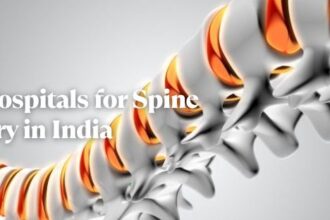For people with chronic knee discomfort brought on by arthritis, trauma, or other degenerative diseases, Knee Replacement Surgery is a life-changing procedure.This surgery helps restore mobility, reduce pain, and improve overall quality of life. But after the surgery is finished, the journey continues. But after the surgery is finished, the journey continues. The recovery phase is just as important in ensuring the long-term success of the procedure. With proper care, physical therapy, and patience, patients can recover comfortably and return to their normal activities.
In this blog, we will provide you with essential tips for a comfortable recovery after knee replacement surgery, focusing on pain management, rehabilitation, and daily activities.
Step into a pain-free future – your knee’s recovery journey starts here!
Follow Your Doctor’s Instructions Carefully
After undergoing Knee Replacement Surgery, one of the most important things to ensure a smooth recovery is following your doctor’s instructions. These guidelines are tailored to your specific condition, surgical approach, and overall health. Skipping or neglecting these steps can hinder your recovery and delay the healing process.
Key Doctor’s Instructions to Follow:
- Medication Schedule: Ensure you take pain medications and anti-inflammatory drugs as prescribed.
- Physical Therapy: Start your physical therapy as soon as the doctor allows. It’s crucial for regaining movement and strength in your knee.
- Activity Restrictions: Follow your doctor’s recommendations regarding weight-bearing activities and any movements you should avoid during the recovery phase.
By adhering to these guidelines, you give yourself the best chance of a successful and comfortable recovery from knee replacement surgery.
Physical Therapy: The Key to a Successful Recovery
Physical therapy is the cornerstone of a successful knee replacement surgery recovery. The aim of physical therapy is to help you regain strength, improve flexibility, and increase the range of motion in the knee joint. In the early stages of recovery, your physical therapist will guide you through gentle exercises and movements to restore mobility.
Benefits of Physical Therapy:
- Strengthening Muscles: Strengthening the muscles around the knee will provide better support for the joint.
- Improving Range of Motion: Regular therapy helps you achieve a full range of motion and flexibility in your knee.
- Reducing Swelling: Targeted exercises can help alleviate swelling and stiffness, making the recovery more comfortable.
It’s important to remain committed to your physical therapy regimen, as it speeds up recovery and minimizes complications. Make sure to communicate openly with your physical therapist about any discomfort or difficulty you encounter during exercises.
Wanna Read More:- How To Find Medical Treatment In India?
Managing Pain and Swelling
After knee replacement surgery, experiencing pain and swelling is common. However, managing these symptoms effectively can significantly enhance your comfort and speed up your recovery. Swelling can make it difficult to move your knee, while pain can limit your ability to perform daily activities or therapy.
Pain Management Strategies:
- Use Ice Packs: Applying ice to the knee for 20-30 minutes several times a day will help reduce swelling and numb the area to ease pain.
- Elevate Your Leg: Elevate your leg above the level of your heart to reduce swelling, especially during rest.
- Pain Medications: Take pain-relief medications as prescribed by your doctor to control discomfort and inflammation.
By managing pain and swelling early on, you can increase your mobility and comfort as you progress through the recovery process.
Focus on Rest and Elevation
While physical therapy and gradual activity are important, rest is equally essential for healing. Resting your knee allows your body to heal itself and helps avoid tension on the joint. Proper elevation can also significantly reduce swelling and promote fluid circulation, which is vital for healing.
How to Rest and Elevate Properly:
- Resting: Ensure you get enough rest, especially during the first few weeks following surgery. Avoid standing or walking for extended periods.
- Elevating Your Leg: When lying down or sitting, prop up your leg using pillows so that the knee is elevated above heart level.
Resting and elevating the knee will aid in quicker recovery, reduce discomfort, and help with inflammation control.
Gradually Increase Your Mobility
It’s essential to keep the knee joint moving, but it’s just as important to not overdo it in the early stages. Once your doctor approves, start by walking short distances with the help of crutches, a walker, or a cane. Gradually increase your walking distance as your knee becomes stronger and more stable.
Recommended Activities for Mobility:
- Walking Short Distances: Start with short, assisted walks and gradually increase the distance as your strength improves.
- Gentle Range of Motion Exercises: Stretching exercises help prevent stiffness and promote flexibility.
- Stationary Cycling: Once the doctor clears you, using a stationary bike can help increase mobility while being gentle on the knee.
Building up your activity level slowly allows your knee to adapt to the new movement without overexerting it, which is crucial for long-term success.
Read More:- What Do You Mean By Stem Cell Therapy In India?
Protect Your Knee During Daily Activities
After knee replacement surgery, it’s important to protect your knee as it heals. Simple movements like standing, sitting, and walking need to be done carefully to avoid putting undue pressure on your joint. Using assistive devices, such as crutches or a walker, can help you maintain balance and stability.
Tips to Protect Your Knee:
- Assistive Devices: Use crutches, walkers, or canes to maintain balance while walking and standing.
- Avoid Twisting Movements: Your knee may be too stressed by twisting motions. Be mindful when turning or changing directions.
- Proper Sitting and Sleeping Positions: Ensure your knee is supported when resting or sleeping to avoid additional strain.
Taking these precautions will prevent complications and protect the new joint as you recover.
Nutrition and Hydration: Fueling Your Recovery
Your recuperation following knee replacement surgery depends on eating a nutritious diet. Eating foods rich in vitamins, minerals, and protein will aid in healing and provide the energy necessary to participate in physical therapy and daily activities. Proper hydration is equally important to reduce swelling and improve circulation.
Key Nutrients for Healing:
- Protein: Lean meats, eggs, and plant-based proteins help rebuild tissues.
- Anti-inflammatory Foods: Fruits, vegetables, and nuts can help reduce inflammation.
- Calcium and Vitamin D: Crucial for bone health, especially after surgery.
Make sure you stay hydrated, as it helps prevent blood clots, regulates body temperature, and supports overall healing.
Stay Positive and Patient
Recovery from knee replacement surgery takes time, and it’s normal to feel frustrated or discouraged at times. However, staying positive and patient is crucial to maintaining motivation and focusing on your long-term recovery goals. Take one day at a time and celebrate small victories along the way, whether it’s increasing your walking distance or completing a therapy session.
Conclusion
Knee Replacement Surgery is an effective solution for restoring mobility and reducing pain, but the recovery process requires time, effort, and patience. By following the tips outlined above—such as focusing on physical therapy, managing pain, and eating a balanced diet—you can recover comfortably and successfully. Remember, the key to a successful knee replacement surgery recovery is staying committed to your rehabilitation and allowing your body to heal at its own pace.
Trust Aeromedicare to guide you through a smooth recovery journey, ensuring the best care and support every step of the way.
FAQs About Knee Replacement Surgery Recovery
Recovery from knee replacement surgery generally takes 6-12 weeks, but full recovery can take up to a year. The first few weeks involve a lot of rest, physical therapy, and managing pain and swelling. Gradually, you’ll be able to perform more activities with less discomfort.
The timeline for returning to work depends on the type of job you have and how quickly your recovery progresses. Most people can resume sedentary work after six to eight weeks. For physical jobs, it might take longer, typically around 3-6 months.
Until your doctor gives you the all-clear, you should not drive. Most people are able to drive within 6 weeks of surgery, depending on their ability to safely operate the vehicle without pain or discomfort.



